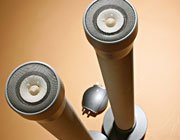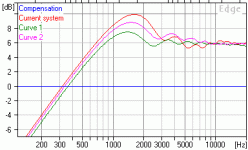#########
##########
Graaf, your pix did not open for me...
one more try, the grey thing around the speaker is the gel cushion
best,
graaf
Attachments
Is the driver its own passive membrane now?
BTW,
I had the Ciare HX201 in PVC tubes and it sounded like tubes, no matter how they were stuffed.
BTW,
I had the Ciare HX201 in PVC tubes and it sounded like tubes, no matter how they were stuffed.
That's a generous assessment of car fi. Any time I try digging for drivers which have meaningful specs I end up looking at European parts. Thanks for the pointer; TspCheck defines Qms and Rms as reciprocals of each other moderated by a constant---Qms = 2 pi Fs Mms / Rms---so calculation's easy enough. Most of the drivers with Qms > 10 have quite light cones, however.Here are the formulas for calculating TSPs:
HAUPT
For the bass section I would ask for "free air" woofers in a car hifi forum.
After some consideration I'm inclined to use an 8 inch midbass instead of a 10 inch. Means moving the low crossover up to 150-200Hz in exchange for improved dispersion at the high end, which I'm fine with, and I like the aesthetics better. The drivers I keep coming back to are Peerless and Selenium, specifically the 830869 and 8MB4P. The 830869 has both a lower Qms (5.7) and a lower Rms (1.01) than the 8MB4P (10.6 and 1.23). It's also longer throw so it crosses lower more easily and has a flatter SPL, so I'm leaning towards the 830869. Any thoughts on which would integrate better with a Neo8? What caught my eye is 830869's Rms is close to the 8W4P Michael's using but the Qms is less than half of the 8W4P's.
Cool, thanks.I will do a new measurement tonight. 🙂
I'd made the same assumption. Now I'm wondering if you actually look like your speakers after all.Haha. That was actually "Walter" (John Goodman) from the movie "The big Lebowski"....
Haha. That was actually "Walter" (John Goodman) from the movie "The big Lebowski"....
😀
great movie that was !
I'd made the same assumption. Now I'm wondering if you actually look like your speakers after all.
LOL !!!
Sorry, I didnt do the measurements I promised, will try again this evening. Was too busy with that darn T-bass circuit....
Off topic:
They say that people gradually start to look like their dogs.... maybe I'm starting to look like my speakers...? I hope not!
They say that people gradually start to look like their dogs.... maybe I'm starting to look like my speakers...? I hope not!
Too generous. I have looked at the product ranges of the established companies. Free air has become popular again, but that only means that their ultra-heavy cones get a weaker mortor. Nothing with high Vas.That's a generous assessment of car fi.
And here's the measurements I promised. The upper trace is 2 cm from the Excel W15CH001 driver, the lower is taken on-axis at 1 meter. It looks like the dipole peak is at 1630 Hz. I did a measurment at 90 degrees as well that verified this.
The calculated value based on the chassis diameter is 1750, the real value 1630. That just 7% off.
I actually use two of these drivers, mounted closely. Interesting to see that this arrangement does not change the dipole peak.
The calculated value based on the chassis diameter is 1750, the real value 1630. That just 7% off.
I actually use two of these drivers, mounted closely. Interesting to see that this arrangement does not change the dipole peak.
An externally hosted image should be here but it was not working when we last tested it.
No comb nulling
Interesting that there is no hint of comb nulling above the peak. The response is very even on both sides. Also, how the metal cone ringing changes from triple peaks to an easy Q, symmetrical hump. Nude dipole really measures excellent.
And here's the measurements I promised. The upper trace is 2 cm from the Excel W15CH001 driver, the lower is taken on-axis at 1 meter. It looks like the dipole peak is at 1630 Hz. I did a measurment at 90 degrees as well that verified this.
The calculated value based on the chassis diameter is 1750, the real value 1630. That just 7% off.
I actually use two of these drivers, mounted closely. Interesting to see that this arrangement does not change the dipole peak.
An externally hosted image should be here but it was not working when we last tested it.
Interesting that there is no hint of comb nulling above the peak. The response is very even on both sides. Also, how the metal cone ringing changes from triple peaks to an easy Q, symmetrical hump. Nude dipole really measures excellent.
Cool. Am I correct in assuming the calculated value is from Edge?The calculated value based on the chassis diameter is 1750, the real value 1630. That just 7% off.
I wouldn't expect to see much; real drivers are large enough there's plenty of path length diversity. I am somewhat surprised at how smooth the curves are.sendler said:Interesting that there is no hint of comb nulling above the peak
Last edited:
My calculated values are from EDGE, yes. Great tool by the way.
This mids measures smooth indeed, its the best I've seen myself so far. That 1 meter measurement is smoothed 1/3 octave though (sorry - force of habit...) There's a new graph below without any smoothing! Its shows that the breakup ringing is still there at 1 meter, but its still remarkably smooth around the dipole peak at at lower frequencies.
This mids measures smooth indeed, its the best I've seen myself so far. That 1 meter measurement is smoothed 1/3 octave though (sorry - force of habit...) There's a new graph below without any smoothing! Its shows that the breakup ringing is still there at 1 meter, but its still remarkably smooth around the dipole peak at at lower frequencies.
An externally hosted image should be here but it was not working when we last tested it.
If you used just the diameter of the W15, 146mm, you'd get an Fpeak of about 2350 Hz (343/.146). Looks like Edge gets you much closer than the simple calc.
Last edited:
Additionally EDGE will show you, how the dipole peak frequency is a function of the ratio of basket dia to cone dia. Picture is 18 cm basket with 178 (green), 148 and 118 (red) cm dia cone. Was something like a surprise for me:Looks like Edge gets you much closer than the simple calc.
Attachments
Last edited:
Curve 1?
So which one is green curve 1?Additionally EDGE will show you, how the dipole peak frequency is a function of the ratio of basket dia to cone dia. Picture is 18 cm basket with 178, 148 and 118 cm dia cone. Was something like a surprise for me:
I can only hope as much for my driver selection. 😛There's a new graph below without any smoothing! Its shows that the breakup ringing is still there at 1 meter, but its still remarkably smooth around the dipole peak at at lower frequencies.
178. One of the reasons I'm tempted to mill down the flange on my Neo3s.So which one is green curve 1?
So, after some more investigation, it seems I have the space for a single 15 inch woofer and the Edge based method we've come up with in the last page or so indicates a pro 8 inch driver should provide sufficient SPL as well. So, instead of the 830869 and 830669, I'm looking at using the Selenium 8W4P and 15PW5 crossed around 150Hz. However, I notice the datasheets for both of these drivers show rather odd free air phase behavior around Fs.
StigErik, have you seen any drivers with similar behavior? I've a certain skepticism about the data as the resonances I've seen all have symmetrical peaks around a wrap through 180 degrees. But my experience so far is datasheets are remarkably good predictors of actual behavior. Neither Allocator or PLParEQ are capable of correction in this case. While I'm sure there's a suitable phase shifter VST plugin to fix things up somewhere I haven't found it yet. Hence, I've a certain concern over using the Selenium drivers.
StigErik, have you seen any drivers with similar behavior? I've a certain skepticism about the data as the resonances I've seen all have symmetrical peaks around a wrap through 180 degrees. But my experience so far is datasheets are remarkably good predictors of actual behavior. Neither Allocator or PLParEQ are capable of correction in this case. While I'm sure there's a suitable phase shifter VST plugin to fix things up somewhere I haven't found it yet. Hence, I've a certain concern over using the Selenium drivers.
Last edited:
- Home
- Loudspeakers
- Multi-Way
- Beautiful Swingin' Speaker

